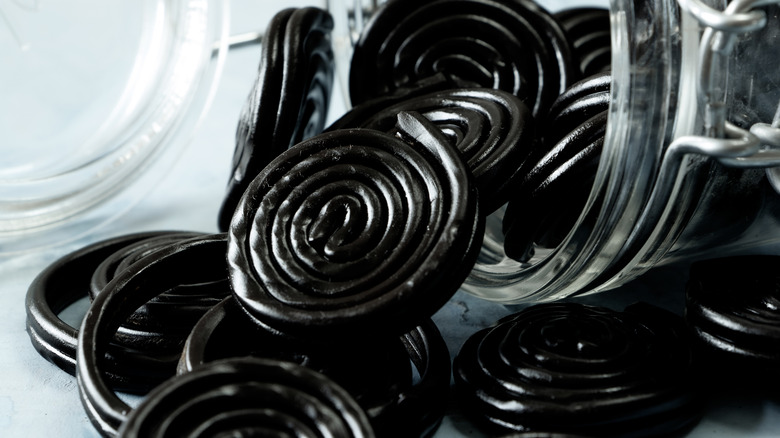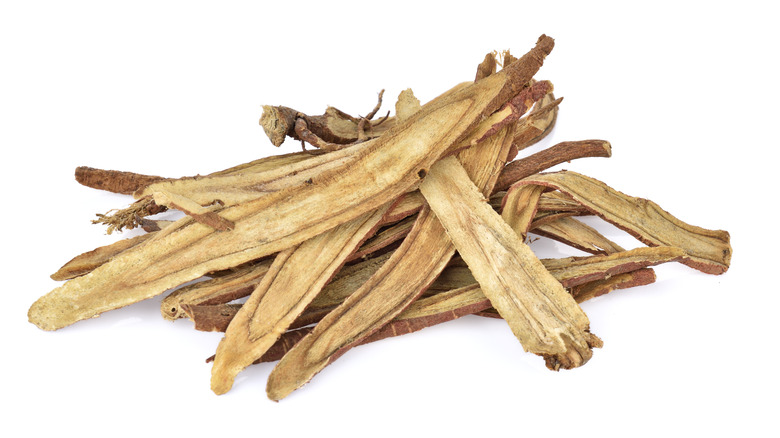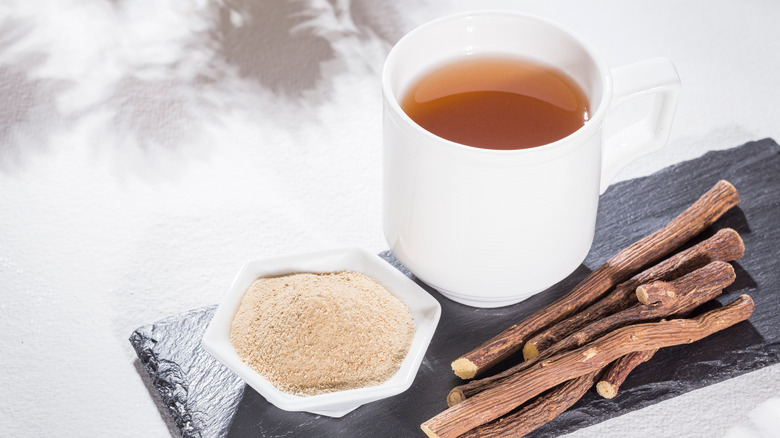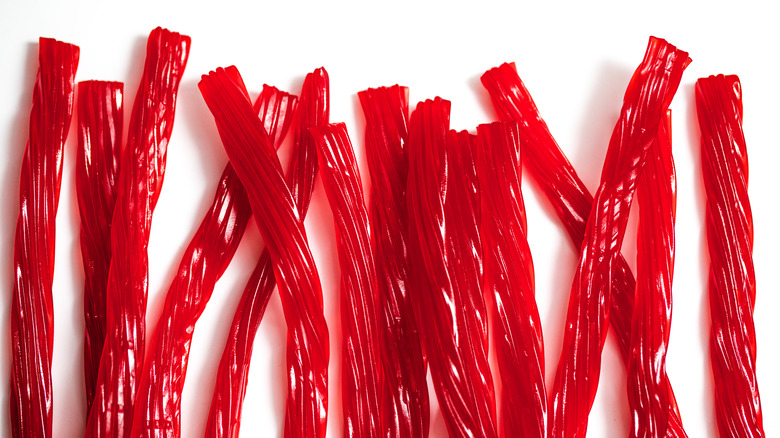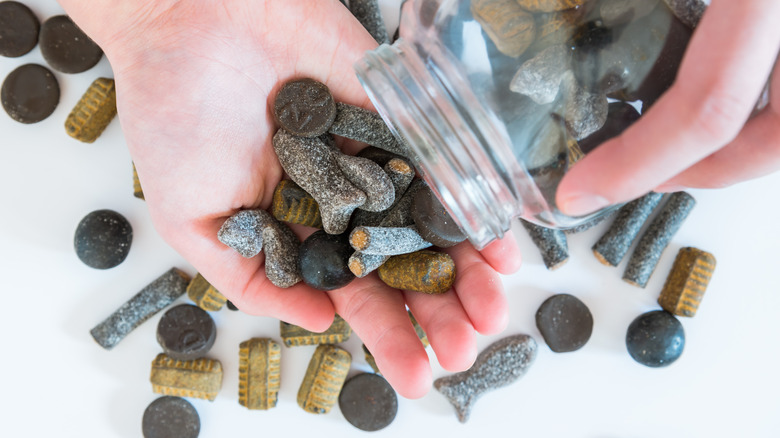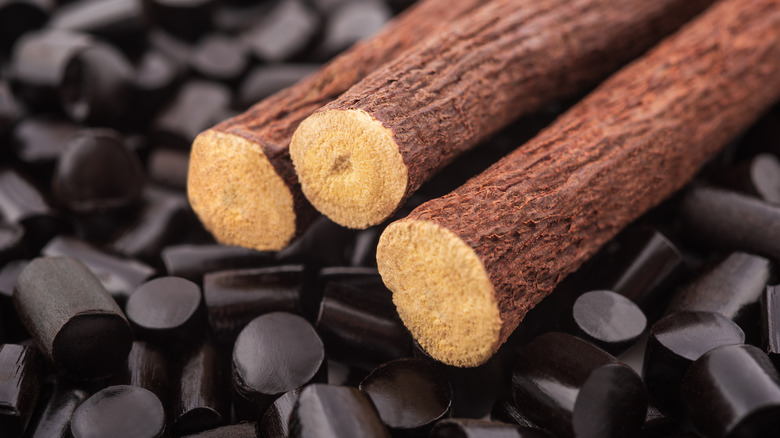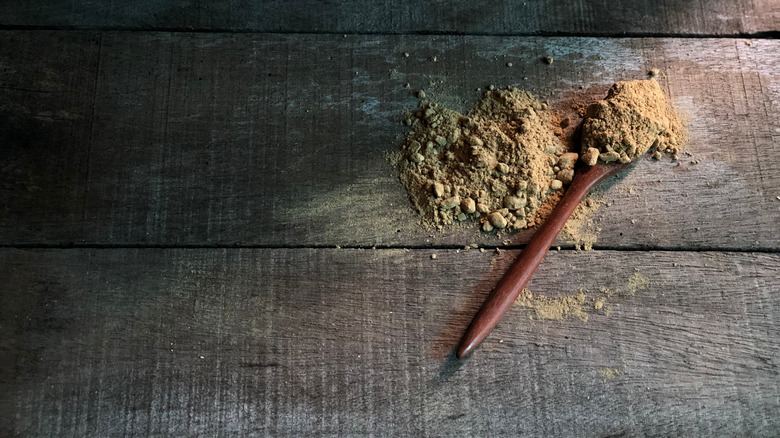The Untold Truth About Black Licorice
Black licorice is one of those things that people either love or hate. You either grew accustomed to the taste of this unique candy through your childhood or some serious application as an adult, or you've been shocked by the bitter taste at some point in your life. Of course, it might also be a reaction due to your unique genetic makeup, so don't get too down on yourself if you really can't stand the stuff. It's probably safe to say that we've nearly all eaten some type of licorice candy in our lifetime, whether it was black or red and came in a long twist or a more compact swirl.
But what does it mean that a piece of candy is technically licorice and not just some other form of chewy candy? Where does the bitter black licorice flavor come from? Are you aware of all of the health claims associated with black licorice? It turns out that true black licorice has been around for way longer than you might think and is still widely popular in quite a few Nordic cultures.
More recently, black licorice has been Americanized, popularized, and turned into treats of all shapes and colors. Let's dig in and find out everything you didn't already know about the rather notorious candy known as black licorice.
Black licorice is made from licorice root
Most candy is basically made from sugar and a bunch of artificial ingredients that you probably can't pronounce unless you have a food science degree. However, black licorice is not like many other candies, largely because it actually has an herbal component to it. Black licorice candy is actually made from the licorice root, from the plant with the scientific name of Glycyrrhiza glabra. Now, that's a mouthful! Per Britannica, this plant is native to southern Europe and is actually a part of the legume family. Licorice root extract is what gives it that distinct herbal flavor that you either love or hate. During most candy manufacturing processes, the extract is mixed with sugar and a binder to make the licorice candy we know.
Licorice root has been used in Europe for various purposes since prehistoric times, according to the Journal of Ethnopharmacology. The extract has also been used to make various alcoholic drinks like Jägermeister, and Scandinavians have gotten quite creative with licorice-flavored liqueurs, according to Nordic Spirits.
It was once used medicinally
Licorice root is nothing new to herbal medicine. According to Healthline, ancient cultures as far back as the ancient Egyptians used it to make a special drink for their rulers. Meanwhile, it became a feature of traditional medicine in Chinese, Greek, and Middle Eastern cultures, where physicians and herbalists typically used the stuff to treat digestive and respiratory issues.
Turning the extract into a beverage seems to have been a popular way of administering the health benefits of licorice root. The Egyptians made a sweet drink out of it, according to the journal Therapeutic Advances in Endocrinology and Metabolism. In fact, the scientific name of the licorice plant suggests sweetness, though you may want to argue otherwise if you unwisely chew on a raw licorice root. Turns out that glycyrrhiza can be broken down into the Greek roots word of "glykos," which means sweet, and "rhiza" for root. Not only was the taste of licorice root drinks meant to be sweet in many settings, but the root was also used to quench thirst among soldiers in battle.
You can make your own licorice at home
If you are intrigued by the truth behind what black licorice is made of, you might like to try your hand at making it from home. You might try some recipes which often call for butter, sugar, corn syrup, milk, and flour to produce a pretty sweet confection. You may also encounter quite a few calls for anise extract across various homemade black licorice recipes. To clarify, The Spice Guide notes that anise extract is not the same as licorice root extract, though they may have a similar flavor profile to many tasters. Yet, the truth is that anise seed and anise extract comes from a different plant that's actually related to parsley, while genuine licorice root is related to legumes.
According to The Spice Guide, another difference is that anise extract is most often used to flavor food, not cure ailments. However, the two plants taste similar, so quite a few people refer to them almost interchangeably. What does all that have to do with making your own licorice at home? First, you don't have to source licorice root and make your own extract. Instead, you can just buy anise extract from your local grocery store to get a similar flavor profile, though you should know that it won't be genuine black licorice candy if it's missing the titular ingredient. Still, anise extract could be close enough to pass muster for many licorice enthusiasts regardless.
Red licorice is not real licorice
Some Americans might tell you that they actually like licorice, but it's possible that many of them are referring to red licorice candies such as Red Vines and Twizzlers. We hate to break it to you, but that's not real licorice. According to the American Licorice Company, the rather fruity-tasting candy known as red licorice is actually not made with licorice extract at all. Instead, it's essentially just chewy gummy candy shaped like licorice in rolls, straws, or twists. Sure it's tangy and chewier than, say, gummy bears, but don't be fooled by the name alone. The red "licorice" you're eating is not licorice. It's just regular old candy. There's nothing wrong with enjoying it, to be certain — just don't fool yourself into thinking it's real licorice.
Without the Glycyrrhiza glabra extract, red licorice is just candy and arguably doesn't meet the licorice criteria. Red licorice is undeniably more palatable and more popular among Americans and other black licorice-adverse snackers, so it's no wonder that we see it everywhere and associate the word licorice with it. It is true that its texture and shape are similar to that of genuine licorice. But note that both Red Vines and Twizzler packaging actually doesn't even say the word "licorice" on it. That's all you really need to know, isn't it?
There's a salty black licorice
Salty black licorice, or "salmiakki", as it is known in Scandinavia, Finland, and Holland is essentially black licorice 2.0, according to the BBC. If you're wondering what makes it so special, first know that it's not just black licorice sprinkled with plain old table salt. Instead, it's got some added ammonium chloride — but don't let the chemical name turn you off. According to Britannica, ammonium chloride is simply salt that's been derived from ammonia and hydrogen chloride. It is the compound responsible for the salty, spicy, and undeniably unique taste of this treat.
Many Finnish and Scandinavian folks grew up on this stuff and love the sweet and salty combo with a bit of kick to it. Hundreds of years ago, salmiakki was actually used in cough medicine in Nordic countries (via Nordic Spirits). It's no wonder that, as Britannica notes, the ammonium chloride found in this treat is still used in some expectorant medications meant to help with persistent coughs. Indeed, as NBC News reports, "cough syrupy" is how many Americans might describe the taste of black licorice.
Stories of Americans tasting salty black licorice, like those reported by Vice, are comical and perhaps a little frightening to the uninitiated, as many people explained that their tongues felt raw and their salivary glands went on overload. But if you wait long enough to taste the ffull flavor of this treat, you just might find yourself turning into a salmiakki lover after all.
The FDA warns you about eating too much licorice
Remember the fancy Latin name of the licorice plant? That's Glycyrrhiza glabra, if you need a refresher. Well, according to the U.S. Food & Drug Administration, glycyrrhizin is a compound found in the plant that can actually cause your body to lose too much potassium if you overindulge in the stuff. That can be dangerous for your heart and cause a myriad of health problems, from heart arrhythmia to muscle weakness. Eating black licorice as a treat here and there seems to be totally safe though, but the FDA warns people against consuming too much black licorice at once.
The glycyrrhizin found in black licorice may also mess with different supplements and medications. So if you're going to binge on some licorice, maybe reach for the fruity non-licorice kind instead. That's especially important if you're taking medications that might produce an unpleasant or even dangerous interaction when mixed with the compounds found in black licorice. So, even if you're amongst the group of candy consumers that really, really goes for black licorice, you should still remember that there is such a concept as too much of a good thing.
There are potential health benefits to consuming black licorice
Though the FDA warns against overindulging, in today's society there are actually still some benefits to consuming black licorice root, in moderation. According to the Journal of Dermatological Treatment, a licorice-derived gel can be effective in treating some skin conditions like eczema. It has also been shown to reduce coughing in people with a breathing tube right after removing it.
Other uses of licorice root today include soothing an upset stomach and soothing a sore throat, much like the uses employed by our ancient ancestors. and it might even prove useful in treating liver disease, some cancers, and a variety of microbial infections, per BMC Complementary Medicine and Therapies. Not to mention, licorice root can be used to make a cup of tea that is full of vitamins A, C, and E, per WebMD. There are numerous other claims and ideas about how licorice root may be used as a health remedy, but many of them lack research and sufficient evidence. So by all means, give this bitter candy a try — just do so a little at a time.
